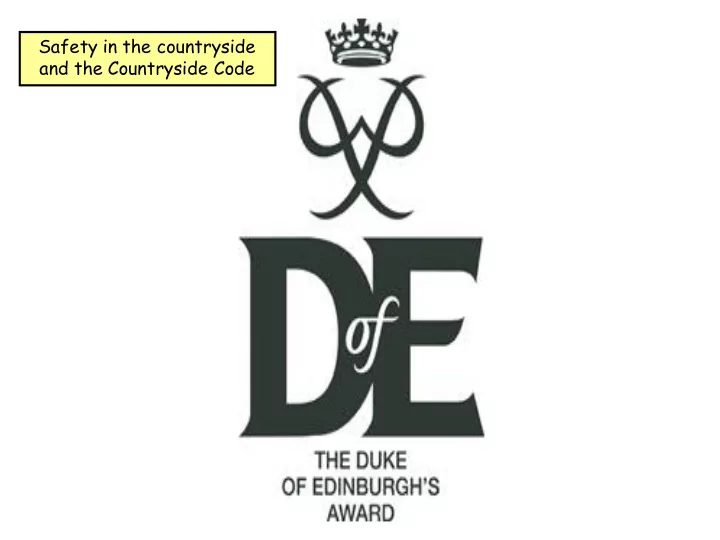

Safety in the countryside and the Countryside Code
The Countryside Code. What could be the What ‘rules’ exist when consequences of me not I’m out in the sticking to the Countryside countryside? Code? What is the Countryside Code? When you are out and about in the Countryside you should enjoy yourself but it should not be at the expense of others. Remember, the farmland you cross on footpaths belongs to someone. It is their property and working environment. When you are out on an expedition, you are representing yourselves, your parents, the school and most importantly, the Duke of Edinburgh Award.
The Countryside Code What do you know about this already?
C.C. leaflet
Responsible Access Responsibility is covered in the country code While in the countryside, whether on a Day Walk or Expedition, you must stick to the rules of the Countryside Code. Main points – Be safe, plan ahead and follow any signs. Leave gates and property as you find them. Protect plants and animals and take your litter home. Keep dogs under close control. Consider other people. C.C. 2010 C.C. A4 If YOU are the person who opens a gate, make sure YOU are the person who closes the gate.
Public Rights of Way • Until recently hill goers only had certain legal right to walk on Public Rights of Way • England and Wales - 1:50,000 shown as red, 1:25,000 shown as green • Scotland - 7,000 rights of way – not shown on maps Unless you are walking on Open Access land, you should always be walking along a footpath while on D of E .
A B Which photograph shows a footpath? C D They all do! Don’t expect to see a clear track in front of you. The footpath will be marked on the map but not always obvious on the ground. Trust the map and follow the footpath marked. To avoid unnecessary footpath erosion, try to always walk in a line along the path. What would you do if you came across a field where there was a footpath but the field had crops in it?
Closures and restrictions Farmers and Landowners have the discretion to suspend or restrict access for 28 days each year, for any reason. They can also apply for long-term restrictions where necessary for land management, safety or fire prevention. If you do find a footpath closed, you should find a diverted route nearby. Dog owners must keep dogs on a lead of no more than 2m long, between 1st March and 31st July.
Look at some of the following slides – where people may not have stuck to the Countryside Code.
1 Dropping litter is not only unsightly but could pose potential risks for wildlife and farm animals. Take all litter home .
2 Never climb over walls or fences. It can cost up to £100 a metre to fix a dry stone wall. Only cross field boundaries using stiles and kissing gates . Whoever did the damage above could be liable to criminal prosecution.
Ensure you cross over a stile safely! This may seem daft but over the years there have been cases of students slipping and falling on stiles. Slip and end up with a painful twist or strain and you may not be able to complete an expedition. Always ensure that you have three points of contact when crossing over a stile. Wait until everyone has crossed over before you continue along the footpath or bridleway.
3 You may find some landowners do not like having a footpath cross their land. They have to provide access by law. This is private land, you would not go through this gate. In a situation like this you would probably find the footpath and access off to the side of the gate.
4 Dogs should usually be kept on a lead, especially between March and July. Farmers are well within their rights to shoot dogs off their leads which are running around on their land.
5 A blue arrow A yellow arrow indicates a bridle indicates a public way . footpath . Make sure you are aware of what symbols mean and whether you actually have rights of access. Stick to paths and walk in single file. If the field has a sown crop, walk around the edge of it.
6 Never pick any wild plants, even ones you think you may recognise. They could be poisonous and many endangered wild plants are protected by law.
7 Be considerate of others using footpaths and bridleways. Stand to one side to let walkers or cyclists past (you shouldn’t see the latter on a footpath).
8 Take care not to create any potential risk of fire. On the campsite, take care with discarded matches when lighting your stove, especially in dry weather.
Have a good time while out in the countryside and enjoy yourself but you must ensure that you follow the Countryside Code. Remember, you are representing; • Yourself and your parents • Your group • Your school • And most importantly D of E.
Nationally, there are around 275 000 young people doing their D of E in the UK. Imagine the impact on the countryside if none of these people followed the Countryside Code? In the summer of 2014, the D of E Head Office received numerous reports of groups leaving litter at camp sites and trails of sweet wrappers through rural villages. A growing number of camp sites no longer welcome D of E teams. In many areas of the country there have been remarks about how many groups leave gates open, stray off public rights of way and one group even used a resident’s garden furniture for their lunch break! Make sure YOU and your GROUP all follow the Countryside Code.
Remember, you can revisit any of these power-point resources by going onto the dofe area on the school website. Don’t forget to check this, at least once a week.
Recommend
More recommend